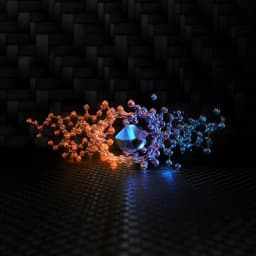
Chemistry
Direct demonstration of triplet excimer in purely organic room temperature phosphorescence through rational molecular design
Z. Liu, Y. Tian, et al.
Discover the fascinating world of organic luminogens demonstrating room temperature phosphorescence, as researchers including Zhenjiang Liu and Yu Tian reveal how variations in molecular packing impact RTP emission. This study unveils the exciting dynamics of dimers, where strong π–π stacking leads to triplet excimer emission, and weak stacking showcases dual RTP from both monomer and excimer forms.
~3 min • Beginner • English
Introduction
The study addresses how molecular aggregation, particularly dimer formation and π–π stacking, governs room temperature phosphorescence (RTP) in purely organic luminogens. While molecular structure (single-molecule electronic properties) has traditionally been emphasized, many photophysical behaviors, including excimer formation and RTP, are highly sensitive to aggregate packing. The relationship between molecular dimers and RTP emission remains unclear, especially whether RTP can originate from triplet excimers. To clarify this, the authors design a model system comprising eight phenothiazine-5,5-dioxide-based luminogens (2PtzO-nC, n = 3–10) with two RTP cores linked by non-conjugated alkyl chains to modulate packing without altering monomer electronic structure. This enables simultaneous observation and discrimination of monomer versus dimer-related RTP within one molecular platform, aiming to directly demonstrate triplet excimer phosphorescence and establish packing–property correlations important for aggregate science and optoelectronic material design.
Literature Review
Background highlights include: (1) Organic optoelectronic materials show properties that depend strongly on aggregation, with excimer formation often causing red-shifted emissions in solids. (2) RTP in purely organic luminogens is significantly influenced by molecular packing, with various dimer motifs (H-aggregation, hydrogen bonding, halogen bonding, n–π and π–π interactions) reported to affect emission. (3) Prior work with phenothiazine-5,5-dioxide units indicated planar structures that readily form intermolecular π–π interactions in the solid state, contributing to persistent RTP. However, direct evidence linking dimer π–π stacking strength to triplet excimer RTP remained lacking.
Methodology
- Molecular design and synthesis: Eight target compounds 2PtzO-nC (n = 3–10) were synthesized in two steps via C–N coupling followed by oxidation with H2O2 to give phenothiazine-5,5-dioxide derivatives bearing two RTP cores connected by alkyl linkers of varying length. Structures and purity were confirmed by 1H/13C NMR, HRMS, and HPLC.
- Thermal characterization: TGA and DSC showed no obvious glass transition upon heating. Decomposition temperatures ranged from 389 to 434 °C. Melting points of 2PtzO-7C and 2PtzO-8C exceeded that of 2PtzO-6C, indicating more rigid crystalline environments beneficial for RTP.
- Photophysics in solution and rigid matrices: UV–vis in DCM (10 μM) displayed similar absorption bands (~273, 300, 336 nm) across all compounds, indicating minimal impact of alkyl chain on monomer electronic levels. At room temperature in DCM, only fluorescence (~360 nm) was observed. At 77 K, blue phosphorescence with peaks around ~400 nm and lifetimes 320.5–488.3 ms confirmed monomer phosphorescence characteristics. In PMMA films (doped), RTP was not observed at room temperature; at 77 K, all showed blue phosphorescence with lifetimes 343.1–375.0 ms, again consistent with similar monomer behavior.
- Solid-state/crystal photophysics: Single crystals were grown by slow solvent evaporation. Under 365 nm excitation at room temperature, emission colors varied (green for 2PtzO-3C/7C/8C/9C/10C; blue for 2PtzO-4C/5C/6C). Time-resolved phosphorescence spectra at room temperature showed either a single RTP peak (~500 nm) or dual RTP peaks (~445 and ~500 nm). Lifetimes: 445 nm component 30.3–142.8 ms; 500 nm component 59.8–256.1 ms.
- Crystal structure analysis: Single-crystal X-ray diffraction resolved packing motifs. π–π stacking strength in dimers was quantified by displacement angle (θ, angle between centroid–centroid line and normal) and interplanar vertical distance (d) between adjacent benzene rings. Smaller θ and shorter d denote stronger π–π interactions. Packing was mapped across the series to bilateral/unilateral dimer motifs and correlated with RTP outputs.
- Computational analysis: TD-DFT calculations of T1-state natural transition orbitals (NTOs) for observed dimers were performed. Intermolecular orbital coupling in T1 was assessed to rationalize excimer RTP in strongly stacked dimers.
- Assignments: ~445 nm RTP in crystals is assigned to monomer-derived phosphorescence (red-shifted from ~400 nm in frozen solution), while ~500 nm RTP is assigned to triplet excimer emission from π–π stacked dimers. Comparable or longer lifetimes at 445 nm relative to 500 nm exclude emission from higher triplet states (e.g., T2).
Key Findings
- Monomer baseline: All eight 2PtzO-nC derivatives exhibit similar monomeric photophysics (UV–vis at ~273/300/336 nm; phosphorescence at ~400 nm at 77 K in DCM with lifetimes 320.5–488.3 ms; PMMA films at 77 K lifetimes 343.1–375.0 ms), indicating that alkyl linker length does not significantly alter monomer electronic structure.
- Crystal-state RTP at room temperature segregates into two behaviors:
• Pure triplet excimer RTP (~500 nm) for 2PtzO-3C, 2PtzO-7C, 2PtzO-8C, 2PtzO-10C.
• Dual RTP (monomer ~445 nm and excimer ~500 nm) for 2PtzO-4C, 2PtzO-5C, 2PtzO-6C; and predominantly excimer with weak monomer RTP for 2PtzO-9C.
- Lifetimes: 445 nm component 30.3–142.8 ms; 500 nm component 59.8–256.1 ms. The relative lifetimes argue against high-lying T2 emission for the 445 nm band.
- Structure–property correlation: Strong π–π-stacked bilateral dimers (small θ, short d) correlate with pure excimer RTP. Quantitatively:
• Strong π–π stacking: θ ≈ 17.56°–20.66°, d ≈ 3.56–3.86 Å (2PtzO-3C/7C/8C/10C) → pure ~500 nm triplet excimer RTP.
• Mixed/weak stacking: examples include 2PtzO-9C with one strong dimer (θ = 7.60°, d = 3.76 Å) and one weaker (θ = 40.64°, d = 3.47 Å) → dominant excimer plus weak monomer RTP; 2PtzO-4C and 2PtzO-6C bilateral dimers with θ = 27.02°/30.58° and d = 3.84/4.06 Å; 2PtzO-5C unilateral weak dimer (θ up to 28.83°, d = 4.41 Å) → dual RTP.
• General rule: decreasing θ and d strengthens π–π interaction, increasing the contribution of triplet excimer phosphorescence.
- Computation: TD-DFT NTOs of T1 show pronounced intermolecular orbital coupling for strongly π–π stacked dimers (e.g., 2PtzO-3C/7C/8C/10C), consistent with excimer-mediated RTP.
- Thermal/aggregation context: TGA/DSC indicate high thermal stability (Td 389–434 °C). Solid-state UV–vis shows slight red-shifts consistent with J-aggregation. The series enables tuning of packing via linker length without changing monomer electronics, allowing direct observation of monomer vs excimer RTP.
- Application note: The distinct RTP behaviors enabled multiple anti-counterfeiting demonstrations (details in supplementary figures).
Discussion
The work directly demonstrates that, in purely organic RTP systems based on phenothiazine-5,5-dioxide dimers, triplet excimer emission can dominate when strong bilateral π–π stacking is achieved, while weaker π–π interactions yield competition between monomer and excimer channels, producing dual RTP. By systematically varying alkyl linker length to modulate packing without altering monomer electronic structure, the study isolates dimer packing as the principal determinant of RTP spectral character. The quantitative correlation using displacement angle (θ) and interplanar distance (d) provides a practical structural metric to predict RTP origin. Computational NTO analysis corroborates that strong π–π dimers feature intermolecular coupling in T1 consistent with excimer formation. These findings resolve a key question about the origin of RTP in aggregated organics, establishing triplet excimers as a definitive emissive species under specific packing conditions. This advances aggregate-state photophysics and guides design strategies for RTP materials, enabling rational control over color and lifetime for applications such as anti-counterfeiting and optoelectronic devices.
Conclusion
The authors designed a series of eight bis(phenothiazine-5,5-dioxide) luminogens with tunable alkyl linkers to decouple monomer electronic effects from aggregate packing. They provide direct evidence that strong bilateral π–π stacking in dimers leads to pure triplet excimer RTP at ~500 nm, whereas weaker or unilateral π–π stacking results in dual RTP from monomer (~445 nm) and excimer (~500 nm). The study establishes structural thresholds (small θ, short d) that predict excimer-dominated RTP and validates the mechanism with TD-DFT NTO analysis. This work offers a clear structure–packing–RTP paradigm and a platform for probing aggregate-mediated phosphorescence.
Future directions may include: expanding to other chromophore cores and intermolecular interaction types (e.g., hydrogen/halogen bonding) to generalize the packing–RTP rules; engineering co-crystals or polymorphs to finely tune θ and d; quantifying how bilateral vs unilateral dimerization and crystal rigidity impact RTP quantum yields and stability; integrating design rules into device-relevant host–guest systems.
Limitations
- Generality is presently demonstrated for a single chromophore family (phenothiazine-5,5-dioxide) and a discrete set of linker lengths; extrapolation to other scaffolds or interaction motifs requires further validation.
- RTP assignments rely on correlations between crystal metrics (θ, d), spectroscopy, and TD-DFT; while compelling, direct isolation of excimer vs monomer sites within the same crystal could be further strengthened by spatially resolved spectroscopy.
- Room-temperature RTP was not observed in inert matrices (e.g., PMMA), underscoring dependence on specific crystalline packing; practical implementation may require control over crystallization and polymorphism.
- The excerpt does not report RTP quantum yields or environmental robustness, which would affect application relevance and comparison across materials.
Related Publications
Explore these studies to deepen your understanding of the subject.







